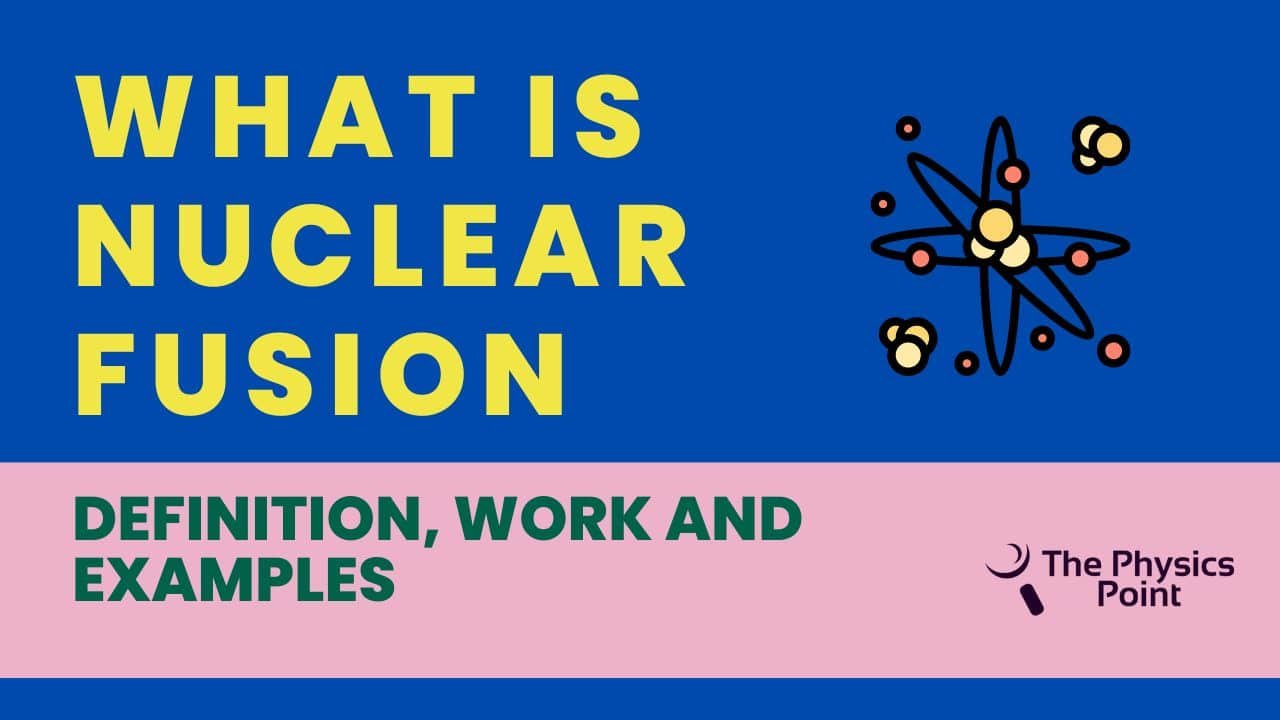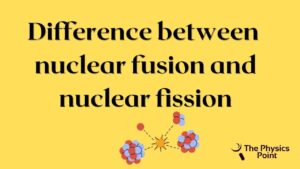What is Nuclear Fusion? Definition, Application and Examples

Hello students and the readers of the Physics website you are again a very warm welcome to a new article on physics what is nuclear fusion? In this article, we will talk about nuclear fusion. this is one of the types of nuclear reactions and it is very important for the existence of the stars as well as for us also. Because the energy we get from the sun is the result of the nuclear fusion reaction. You can also read out the Nuclear Fission article already posted on our website to make your concept clear.
In today’s article, we will describe very important questions such as how nuclear fusion work, nuclear fusion occurs in stars, where does fusion occur in the sun, what triggers nuclear fusion in stars, what is nuclear fusion quizlet, etc. so I request you to that please read this article (What is Nuclear Fusion) from start to the end for better understanding.
What is nuclear fusion (Definition)?
Nuclear fusion is the fundamental reaction of nuclear reactions. in this reaction, two or more light nuclei collide to create a heavier nucleus than the parent nuclei. the nuclear fusion type of reaction happened in an element that has a deficient atomic number that is the proton number of atoms is very low, for example, hydrogen.
The actual definition of nuclear fusion is given as two or more nuclear atoms fusing together to create a single big nucleus then this reaction is called new clear fusion and in this reaction, the matter is not conserved due to some of the mass of the small nuclear change into energy at the time of fusing.

In the Universe nuclear fusion reaction
In our universe, there are lakhs of stars including the sun also, that are blinking in our eyes at the night. the energy in the stars is only possible due to the nuclear reaction that is called nuclear fusion By the help of nuclear fusion the stars including the sun produce an enormous amount of energy and heat also. In the core of the stars, the pressure is at its peak level and here nuclear fusion takes place.
Examples of nuclear fusion
Let’s understand this process with the help of an example. With the help of some calculations, we found that the temperature of the Sun’s core is approx 15 Million degrees centigrade. At this temperature, The two isotopes of the hydrogen element that is deuterium and tritium fuse together to form the new element helium and in this process the energy is released in very very high amounts in the form of heat. According to data, approximately 600 million tons of hydrogen elements are converted into Helium elements every second in the core of the Sun. I hope you understand very well how does nuclear fusion work?
Application of nuclear fusion
In our article on what is nuclear fusion, we describe below some applications and learn them very carefully because these are very important from the exam point of view.
- Least nuclear waste material produced – Generating energy in the fusion reactor will not reduce a very high level of nuclear waste like in the fission reaction. so there is no problem with settling waste material after the energy production in the fusion reactors.
- No Air Pollution – There is no combustion reaction happening in the generation of energy through nuclear reactions. So the chance of air pollution is very very low. We should not worry about air pollution.
- The fuel which we used in the using reaction such as deuterium and tritium are really available in nature. Nuclear fusion generators very minimal amount of nuclear waste. so many scientists hope that this will be a very good source of power in the upcoming year.
Difference between nuclear fusion and nuclear fission
- In nuclear fusion, many small nuclei combined together to form a large nucleus or atom but in the reaction of nuclear fission split into many smaller nuclei.
- The existence of the universe’s stars depends on nuclear fusion reaction because the energy that exists in the stars is only possible due to the reaction of nuclear fusion. But if we talked about nuclear fission, it does not happen naturally. It means we have to induce the nuclear fission reaction.
- The amount of energy produced by nuclear fusion is greater than by nuclear fission. The amount of energy generated in nuclear fission is also of good amount but less than nuclear fusion.
- To occur the reaction of nuclear fusion required a high amount of heat and pressure but Nuclear Fission does not require a high amount of energy or pressure to split any heavy atom into two small nuclei.

Frequently Asked Questions (FAQs)
Ques. What is nuclear fusion?
Ans. When two or more nuclear atoms fuse together to create a single big nucleus then this reaction is called new clear fusion and in this reaction, the matter is not conserved due to some of the mass of the small nuclear change into energy at the time of fusing.
Ques. Where does fusion occur in the sun?
Ans. The Fusion reaction takes place in the core of the Sun where the temperature is Approximately 15 million degrees centigrade and the pressure is very high.
Ques. Which element is used in nuclear fusion reaction in the core of the sun?
Ans. The two isotopes of the hydrogen element that is deuterium and tritium fuse together to form the new element helium and in this process the energy are released in very very high amounts in the form of heat.
Conclusion
It is all about today’s article on what is nuclear fusion. I hope you have learned many knowledgeable things with the help of the article such as fusion energy, what is the nuclear fusion, nuclear fusion reactor, nuclear fusion definition, fusion reactions, nuclear fusion in the sun, nuclear fusion energy, nuclear fusion example, nuclear fusion in stars, etc. If you have any doubts or questions regarding this article What is Nuclear Fusion you can ask us in the comment section box. we will meet again new article on physics very soon.
